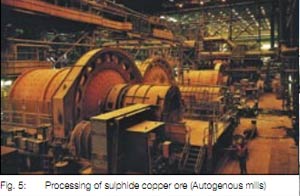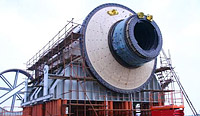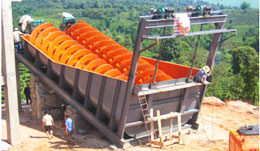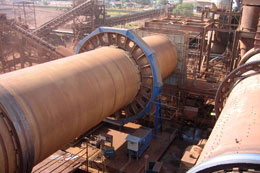-
Sand Making Crusher
- PCL-Vertical Shaft Impact Crusher
- SBM Hydraulic VSI Crusher
- VSI5X Series Impact Crusher
Copper grinding process

This is the process of separating precious minerals from waste rock. At Britannia the copper ore contained just over 1% copper (though in the early years it was around 8%). The remaining 99% was mostly waste rock, called ‘tailings’. In the rock, chemical and physical bonds hold the valuable minerals to the waste rock. Some ore contains minerals in an elemental or almost pure form such as native copper, native silver, etc., but most valuable minerals are compounds, in this case Chalcopyrite (CuFeS2).
The process used to separate the minerals is called ‘concentrating’. Breaking the chemical bonds and separating the elemental copper form the other mineral components is called ‘smelting’ and ‘refining’. This was done elsewhere as there was never a smelter located at Britannia Beach. In the Mill No. 3, the various stages in the milling process took up all of the building. A number of different types of equipment were used to mill the ore as it flowed down from level to level. Some of this equipment is explained below.
Ball mill for copper grinding processing

Grinding – Ball Mills
The ore would then flow into ball mills similar to the rod mills. Steel balls inside the ball mills were about the size and weight of a shot-put ball. These grinding mills rotated anywhere form 1 to 5 times per second.
The end product of the milling process is ore ground to the consistency of sugar or salt (small enough to pass through mesh having 100 holes per square inch). This material is called ‘fines’ and is still mixed with water as it leaves the milling circuit.
- Limestone Crusher
- Barite Crusher
- Granite Crusher
- Kaolinite Crusher
- Calcite Crushing
- Tombarthite Crusher Mill
- Bentonite Grinding Plant
- Basalt Ore Crusher
- Lignite Crusher Mill
- Silica Ore Crusher
- Tin Ore Mine
- Lead and Zinc Ore Crusher
- Ochre Crusher Mill
- Garnet Crusher
- Mica Crusher
- Asbestos Crusher
- Manganese Ore Crusher
- Talc Crusher Mill
- Feldspar Crusher
- Iron Ores Crusher
- Dolomite Crusher
- Quartz Crusher
- Gypsum Crusher
- Calcium Carbonate Grinding
- Copper ore concetrator
- Copper grinding machine
- Copper crushing machine
- Copper mining
- Copper processing
- Copper beneficiation process
- About Us
- |
- Service
- |
- News & Events
- |
- Contact Us
- |
- Resources
- |
- Showroom
Aggregate Crusher
Artificial Sand Making
Ballast Crushing Machine
Basalt Stone Crusher
Barite Mine Process
Beneficiation Plant
Bentonite Crusher
Bentonite Milling
Calcium Carbonate Crusher
Calcium Carbonate Grinding
Cement Grinding
Concrete Crusher
Coal Crusher
Copper Crusher
Cement Mill
Chrome Mining Process
Copper ore Beneficiation
Coal Processing
Coal Pulvarizer
Feldspar Crushing
Feldspar Grinding
Flotation Machine
Gold Crusher
Gold Mine Equipment
Gold Processing Machinery
Granite Crusher
Granite Crushing Machine
Granite Quarry Equipment
Gypsum Crusher
Gypsum Mining
Gypsum Powder Production
Iron Ore Beneficiation
Iron Ore Crusher
Kaolin Processing Plant
Limestone Crusher
Silica Sand Crusher
Iron Ore Mining Equipment
Cement Production Line
Talc Production Line
Quartz Crushing Machine
Limestone Mining Process
Manganese Benificietion
























